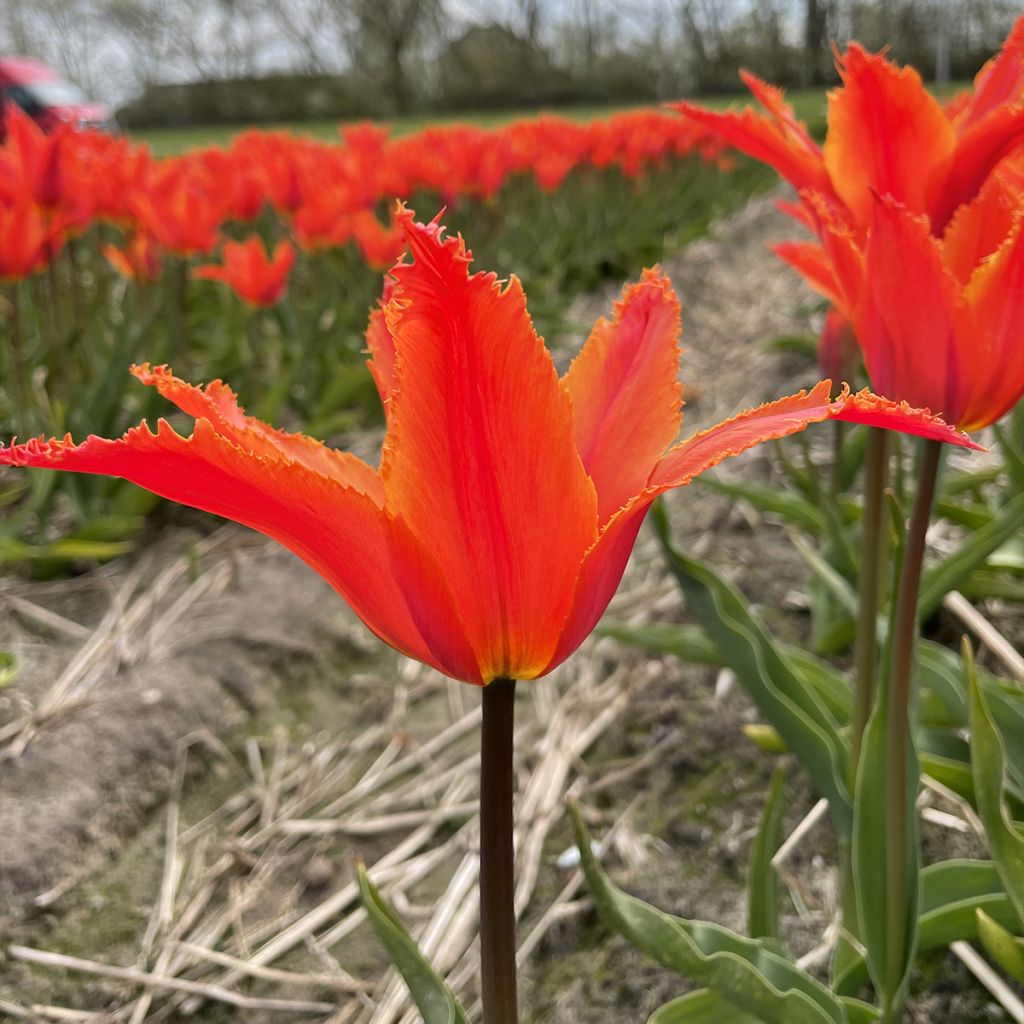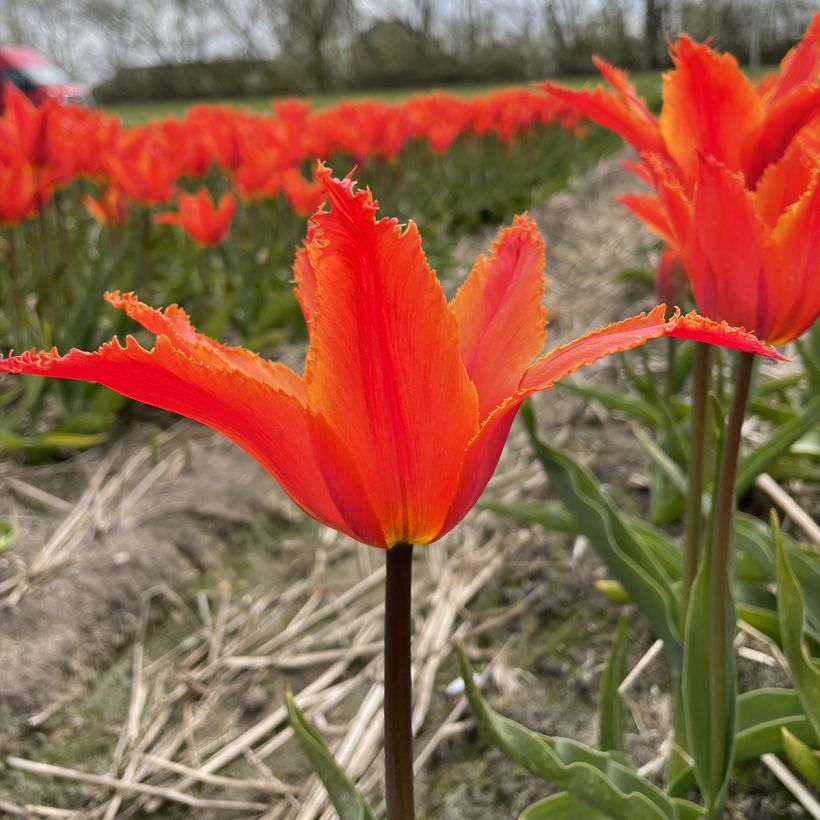

Tulipe Fleur de lis Alexandrine
Tulipa 'Alexandrine'
Tulipa Alexandrine
This plant carries a 6 months recovery warranty
More information
We guarantee the quality of our plants for a full growing cycle, and will replace at our expense any plant that fails to recover under normal climatic and planting conditions.
From €5.90 for pickup delivery and €6.90 for home delivery
Express home delivery from €8.90.
Does this plant fit my garden?
Set up your Plantfit profile →
Description
The 'Alexandrine' Fringed Tulip has a corolla resembling a Fleur de lis with a stylized curve, finely fringed at the edges, and is adorned with a dark orange colour nuanced with yellow-orange, precious for warming up spring flower beds. As a late tulip, it persists well in the garden and faithfully blooms every spring. Carried by a long, sturdy stem, this recent variety is also an excellent cut flower for creating colourful bouquets.
The 'Alexandrine' tulip, registered in the Netherlands in 2019, belongs to the lily family. It is officially classified in division 7 of horticultural tulips, the fringed tulips, whose petal tips are finely toothed. The shape of the flower, on the other hand, places it in division 6 of Lily-flowered Tulips, which have the following main characteristics: they bear single flowers and bloom in the second half of spring, the cups are narrow, and the pointed tepals open in a star shape. During the day, these flowers become arachnoid and widely open. This variety will reach a height of 50 to 55cm (20 to 22in) when in bloom. The flowering takes place around mid-May, emerging from the foliage. Each solitary flower is supported by a seemingly delicate but weather-resistant stem. The foliage naturally yellows and withers a few weeks after flowering, while the bulb enters summer dormancy. Tulips in this Lily-flowered category were created in the early 20th century.
The 'Alexandrine' fringed tulip finds its place in well-organized large flower beds, as well as in contemporary settings, according to the desires of each gardener. Since its flowering is late, it allows for maximizing the duration of flower bed blooms. Pair it with white, yellow, "black," or red varieties, and/or with other spring bulbs. It can be planted in borders, rockeries, flower beds, as well as in pots and containers. This tulip beautifully enhances balconies and terraces. It pairs perfectly with tall perennials and is ideal for creating elegantly filled bouquets. When arranging in a vase, use very little water, just a bottom is sufficient! Furthermore, if your tulips open too quickly, you can add two to three ice cubes to the vase each day. Many varieties of Lily-flowered tulips are grown for forcing and produce cut flowers for a large part of the year.
Report an error about the product description
Tulipa 'Alexandrine' in pictures


Plant habit
Flowering
Foliage
Botanical data
Tulipa
Alexandrine
Liliaceae
Cultivar or hybrid
Planting and care
Plant the bulbs in autumn, from September to December, at a depth of 15cm (6in), spacing them 10cm (4in) apart. The planting should be done in ordinary soil, slightly acidic, neutral, or slightly alkaline, loose, well-worked, and well-drained. Never add manure or poorly decomposed compost to the planting soil, as this could cause the bulbs to rot. The 'Alexandrine' tulip will thrive in moist to dry soil in summer. Plant it in a sunny or semi-shaded location. Once flowering is complete, it is advisable to remove the fruits to avoid exhausting the plant.
Planting period
Intended location
Care
This item has not been reviewed yet - be the first to leave a review about it.
Haven't found what you were looking for?
Hardiness is the lowest winter temperature a plant can endure without suffering serious damage or even dying. However, hardiness is affected by location (a sheltered area, such as a patio), protection (winter cover) and soil type (hardiness is improved by well-drained soil).

Photo Sharing Terms & Conditions
In order to encourage gardeners to interact and share their experiences, Promesse de fleurs offers various media enabling content to be uploaded onto its Site - in particular via the ‘Photo sharing’ module.
The User agrees to refrain from:
- Posting any content that is illegal, prejudicial, insulting, racist, inciteful to hatred, revisionist, contrary to public decency, that infringes on privacy or on the privacy rights of third parties, in particular the publicity rights of persons and goods, intellectual property rights, or the right to privacy.
- Submitting content on behalf of a third party;
- Impersonate the identity of a third party and/or publish any personal information about a third party;
In general, the User undertakes to refrain from any unethical behaviour.
All Content (in particular text, comments, files, images, photos, videos, creative works, etc.), which may be subject to property or intellectual property rights, image or other private rights, shall remain the property of the User, subject to the limited rights granted by the terms of the licence granted by Promesse de fleurs as stated below. Users are at liberty to publish or not to publish such Content on the Site, notably via the ‘Photo Sharing’ facility, and accept that this Content shall be made public and freely accessible, notably on the Internet.
Users further acknowledge, undertake to have ,and guarantee that they hold all necessary rights and permissions to publish such material on the Site, in particular with regard to the legislation in force pertaining to any privacy, property, intellectual property, image, or contractual rights, or rights of any other nature. By publishing such Content on the Site, Users acknowledge accepting full liability as publishers of the Content within the meaning of the law, and grant Promesse de fleurs, free of charge, an inclusive, worldwide licence for the said Content for the entire duration of its publication, including all reproduction, representation, up/downloading, displaying, performing, transmission, and storage rights.
Users also grant permission for their name to be linked to the Content and accept that this link may not always be made available.
By engaging in posting material, Users consent to their Content becoming automatically accessible on the Internet, in particular on other sites and/or blogs and/or web pages of the Promesse de fleurs site, including in particular social pages and the Promesse de fleurs catalogue.
Users may secure the removal of entrusted content free of charge by issuing a simple request via our contact form.
The flowering period indicated on our website applies to countries and regions located in USDA zone 8 (France, the United Kingdom, Ireland, the Netherlands, etc.)
It will vary according to where you live:
- In zones 9 to 10 (Italy, Spain, Greece, etc.), flowering will occur about 2 to 4 weeks earlier.
- In zones 6 to 7 (Germany, Poland, Slovenia, and lower mountainous regions), flowering will be delayed by 2 to 3 weeks.
- In zone 5 (Central Europe, Scandinavia), blooming will be delayed by 3 to 5 weeks.
In temperate climates, pruning of spring-flowering shrubs (forsythia, spireas, etc.) should be done just after flowering.
Pruning of summer-flowering shrubs (Indian Lilac, Perovskia, etc.) can be done in winter or spring.
In cold regions as well as with frost-sensitive plants, avoid pruning too early when severe frosts may still occur.
The planting period indicated on our website applies to countries and regions located in USDA zone 8 (France, United Kingdom, Ireland, Netherlands).
It will vary according to where you live:
- In Mediterranean zones (Marseille, Madrid, Milan, etc.), autumn and winter are the best planting periods.
- In continental zones (Strasbourg, Munich, Vienna, etc.), delay planting by 2 to 3 weeks in spring and bring it forward by 2 to 4 weeks in autumn.
- In mountainous regions (the Alps, Pyrenees, Carpathians, etc.), it is best to plant in late spring (May-June) or late summer (August-September).
The harvesting period indicated on our website applies to countries and regions in USDA zone 8 (France, England, Ireland, the Netherlands).
In colder areas (Scandinavia, Poland, Austria...) fruit and vegetable harvests are likely to be delayed by 3-4 weeks.
In warmer areas (Italy, Spain, Greece, etc.), harvesting will probably take place earlier, depending on weather conditions.
The sowing periods indicated on our website apply to countries and regions within USDA Zone 8 (France, UK, Ireland, Netherlands).
In colder areas (Scandinavia, Poland, Austria...), delay any outdoor sowing by 3-4 weeks, or sow under glass.
In warmer climes (Italy, Spain, Greece, etc.), bring outdoor sowing forward by a few weeks.


































